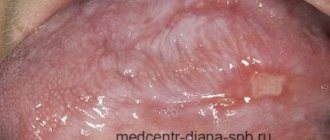Inflammation is a local tissue reaction to any type of injury. It is recognized by the following characteristics:
- erythema (redness);
- edema (swelling);
- dysfunction;
- pain and high body temperature.
Most men will feel changes or notice redness in the penis at some point. The reasons may vary, so it is important to carry out self-examinations regularly. The penis can be affected by various skin diseases, such as psoriasis, infections, some systemic diseases, skin rashes from medications, or allergic dermatitis.
Redness on the glans penis is most often associated with inflammation of the head of the penis. This condition is medically called balanitis.
Causes of redness of the glans penis
The causes of redness of the scalp range from simple ones that do not require treatment to more serious ones that require urgent medical attention. The penis is an organ subject to a certain risk of infection. Because simply urinating creates a risk of infection, and irresponsible behavior increases the risk of sexually transmitted diseases.
The causes of redness of the penis may be:
- Sexual life - during this period, irritation of the sensitive skin of the penis occurs.
- Masturbation and sexual intercourse are a form of trauma, especially when it comes to the contact of the penis with dry skin.
- Infections - during each urination, it is necessary to thoroughly wipe the head of the penis and tighten the foreskin so that not even the last drop of urine remains. Even a drop of urine can cause problems such as inflammation and redness, so good hygiene is important.
- Sexually transmitted diseases - syphilis, genital herpes, Ulcus molle, fungal infections.
- Allergy (contact dermatitis) – most often it is an allergy to latex (condoms).
- Cancer of the glans penis is an extremely rare but possible cause of redness.
- Inflammation of the glans penis (balanitis) - can be caused by bacteria, viruses or fungi in conditions of poor hygiene. A whitish hardening appears at the top of the head.
What complications can there be?
To effectively treat redness of the glans and foreskin, you must consult a doctor at the first sign.
Otherwise, cicatricial phimosis will cause discomfort. This is a pathology that is characterized by deformation of the tissues of the penis. As a result of constant inflammation and deformation, scars form on the tissues. The foreskin gradually narrows, causing the development of phimosis.
In the absence of therapy at this phase, paraphimosis develops - a pathological condition in which the head is pinched. The condition is usually accompanied by painful swelling.
If the form is advanced and without timely treatment, surgical intervention may be required. Also a serious danger is posed by atrophy of the head receptors with a decrease in sensitivity, which, in turn, leads to erectile dysfunction and decreased libido. This negatively affects the quality of sexual life.
With prolonged redness of the head of the penis and foreskin, without timely medical intervention, urethritis develops. Gradually, the infection leads to the development of complications: prostatitis, cystitis, pyelonephritis, orchiepididymitis.
Causes of the disease
The main factors for the spread of infection are:
- poor hygiene;
- the use of antiseptic solutions after sexual intercourse;
- frequent washing of the genitals with soap, leading to skin irritation;
- mechanical damage to tissue integrity;
- uncontrolled treatment with antibacterial drugs;
- anatomical features of the structure;
- hormonal imbalances;
- the presence of certain autoimmune diseases;
- infections.
The disease can be caused not only by sexual (genital) contact, but also by oral and anal contact. Sometimes six months pass before the first symptoms appear.
Symptoms
- Burning in the genital area.
- Pain during sexual intercourse, when urinating.
- Swelling, sharp and burning sensation.
- Exposing the head becomes difficult and pain occurs.
If you have unpleasant symptoms, there is no need to self-medicate and try to find an ointment or gel on your own that will relieve burning and swelling. This always leads to the development of even greater complications, and the infection goes deep into the genitourinary tract.
Symptoms of redness of the glans penis
In addition to redness on the head of the penis, you need to carefully look for other accompanying symptoms:
- other changes on the skin - in the form of abrasions (crusts) or ulcers;
- discharge from the penis;
- feeling of discomfort in the penis;
- difficulty or painful urination;
- painful ejaculation;
- itching;
- swelling or swelling;
- possible peeling of the skin;
- nodules or hardening.
It is important to note that symptoms of sexually transmitted diseases are less severe in men than in women.
Why do red dots and spots appear on the penis?
This sign signals the obvious presence of a pathological process in the body, both infectious and non-infectious.
The first group includes diseases that are often transmitted during unprotected coitus. The causative agents are viruses, bacteria or fungi. Red spots and dots may appear during the development of:
- candidiasis - in addition to isolated formations, a man is bothered by severe itching of the phallus, a whitish coating on the mucous membrane and white curdled discharge from the urethra;
- genital herpes - in this case, blisters with watery contents appear on the head, accompanied by severe unbearable itching;
- chlamydia - with this pathology, red spots on the head of the penis do not itch or hurt, but pus is released from the urethra, and the patient complains of pain in the scrotum, perineum and lower back;
- HPV - the main sign of the disease is a profuse rash; after some time, the rash increases in size, but there is no pain or itching;
- trichomoniasis - in this case, the spots are the result of irritation of the mucous membrane with pus released from the urethra; in addition to these symptoms, the man complains of swelling of the head and pain when urinating;
- balanitis and balanoposthitis - with these diseases, red spots on the penis itch, a burning sensation when urinating is disturbed, a white coating will be noticeable on the mucous membrane;
- syphilis - in the case of this pathology, one pimple turns into an ulcer, the formation does not hurt or itch, disappears after a while, and the patient may think that he has recovered without treatment (but this is a mistaken opinion).
There are other infectious diseases that can cause scarlet rashes to form on the penis. For example, scabies. Its causative agent is the scabies mite. When it penetrates the skin, a small rash occurs, accompanied by severe itching. The patient scratches the problem area, resulting in ulcers. Itchy pimples on the phallus are also characteristic of a viral infection such as molluscum contagiosum.
It's also worth noting that small red spots on the penis that turn into watery, itchy blisters can occur with chickenpox. In this case, the patient’s body temperature will rise, weakness and headache will occur. The rash associated with this disease usually appears on the skin all over the body.
Treatment of redness of the glans penis
Treatment depends on the cause.
In case of mechanical injuries, it is necessary to rinse the penis with warm water and wash with soap with a neutral pH.
Your doctor may prescribe a cream or gel to help wounds and abrasions heal faster if they occur. Also, depending on the cause, anti-inflammatory drugs or antibiotics (for bacterial infection) are prescribed.
With allergies, diagnosis is critical because avoiding the allergen (mostly latex) that causes the redness is often the only way to relieve symptoms.
Sexually transmitted diseases are treated with medications (corticosteroids). They are taken under the supervision of a doctor or pharmacist.
Cancer is a specific disease that usually requires surgery (biopsy or local excision), fluorouracil cream, or laser to treat it.
How to treat?
Prevention of the disease is the best way to avoid serious consequences. And a significant role in this belongs to compliance with the rules of personal hygiene.
If you notice the first signs, it is important to immediately consult a doctor who will prescribe the correct treatment. A paid urologist will conduct an examination and prescribe appropriate treatment.
The private medical clinic “Doctor Anna” has all the necessary equipment to diagnose the disease and invites you to undergo an examination. Experienced specialists will diagnose, identify the causes of the disease and select an effective course of therapy.
Possible diseases
Redness of the urethra on the head in men is one of the main signs of urethritis. The term refers to inflammation of the walls of the urethra. The disease is infectious in nature. In most cases, the causative agents are Trichomonas, mycoplasma, gonococcus, chlamydia and other specific sexually transmitted microorganisms.
Diverticula can also cause redness of the urethra on the head in men. They form on the walls of the urethra and do not cause discomfort. They are sac-like outgrowths 2-3 cm in size. Urethral diverticula make themselves felt when an infectious process develops in them. This occurs due to the accumulation of urine in the resulting cavity. Urine is a favorable environment for the growth of pathogenic flora.
The external opening of the urethra may turn red if a man does not follow the rules of intimate hygiene. The cleanliness of the genitals must be carefully monitored. It is recommended to wash yourself every day, in hot weather - 2 times a day. If this is not done, the number of colonies of streptococcus, staphylococcus, Proteus and E. coli can increase sharply. This will lead to redness of the urethral walls and severe inflammation.
Diagnostics
Which doctor should I contact: a urologist, dermatologist, dermatovenerologist.
First of all, the doctor will take a scraping from the head and a smear from the urethra for analysis by PCR, microscopic examination, and bacterial culture. After ruling out fungal infections and STDs, if necessary, a blood test is prescribed for syphilis, HIV, sugar, and herpes. Blood is taken for immunoglobulins to determine an allergic reaction. To detect prostatitis, prostate juice or ejaculate is examined and an ultrasound scan of the gland is performed. Infection on the head can come from the testicles or their appendages with orchiepididymitis.
It is advisable to check the bladder and kidneys. To diagnose the localization of infection, a three-glass urine sample is used.
The most common cause of redness of the foreskin and head of the penis
The most common cause of redness of the foreskin and head of the penis is a sexually transmitted infection.
The introduction of STI pathogens into the tissues of the genitourinary tract causes the development of inflammatory phenomena in them - hyperemia, swelling, pain.
The development of inflammation is facilitated by weakening of the body's immunity against the background of hypothermia, stress, alcohol abuse, and taking antibiotics.
Additional symptoms
Redness due to STDs is usually accompanied by itching in the urethra, burning sensation of varying severity, and sometimes discharge with an unpleasant odor. In some cases, red spots are the only symptom of the presence of a latent infection. White plaque is characteristic of thrush. Due to the proliferation of candida, the head is very itchy and painful.
With prostatitis, a nagging pain and burning sensation is periodically felt in the area between the scrotum and anus (more about the symptoms of prostatitis). It is felt especially strongly after prolonged sitting. Discomfort may occur during ejaculation or erection. Frequent and intermittent urination is characteristic, accompanied by pain during exacerbation.
In diabetes mellitus, there is increased dryness and flaking of the skin, itching, and constant thirst. The head may be so dry that pain occurs.
In addition to spots on the penis, various types of rashes may appear. Most often it is a sign of infection by sexually transmitted infections, staphylococcus, streptococcus, and bacilli. A white, small, watery rash located in small groups occurs with herpes. It should not be confused with papules along the edge of the head - https://prnt.sc/uwkutx.











